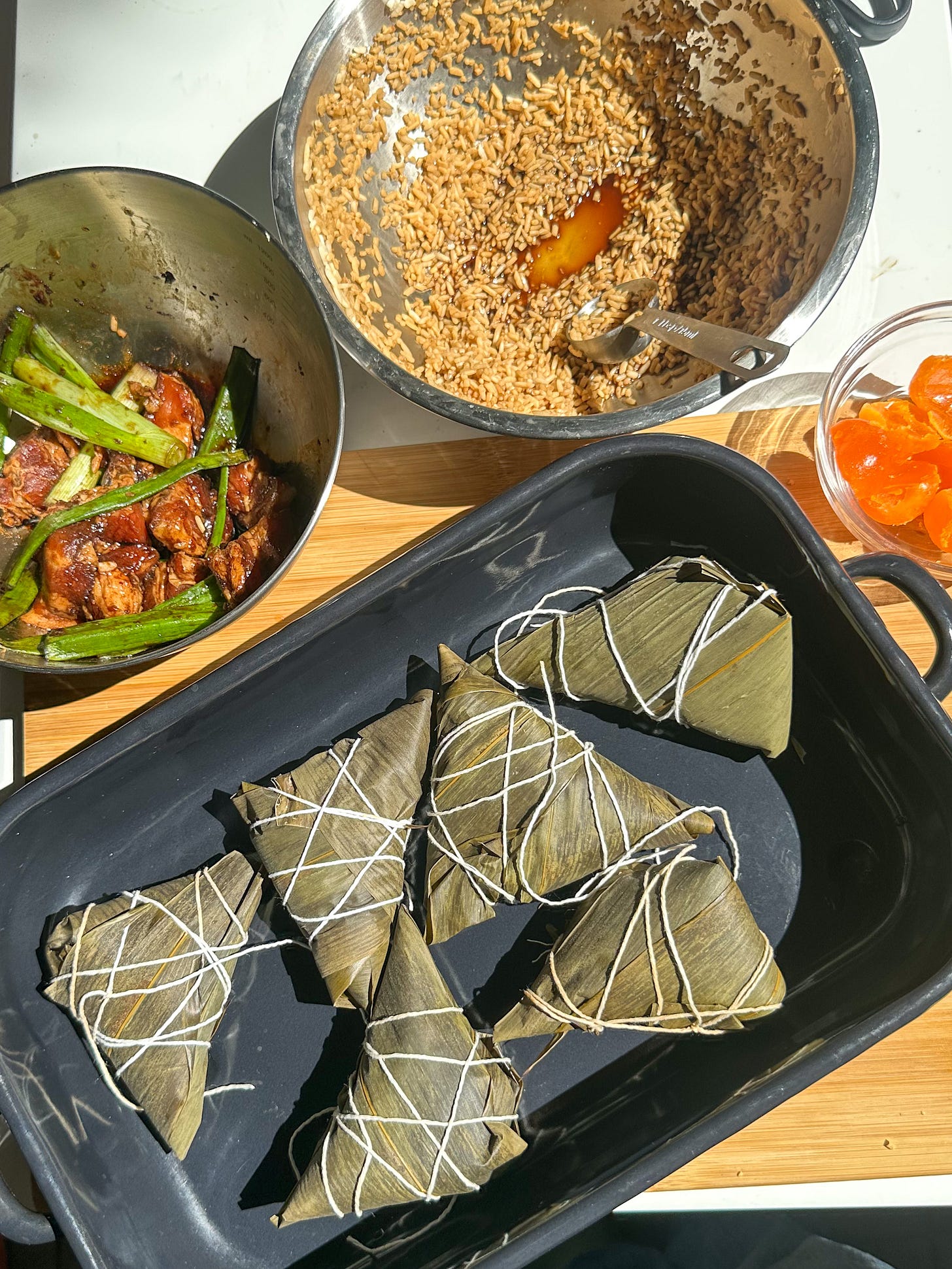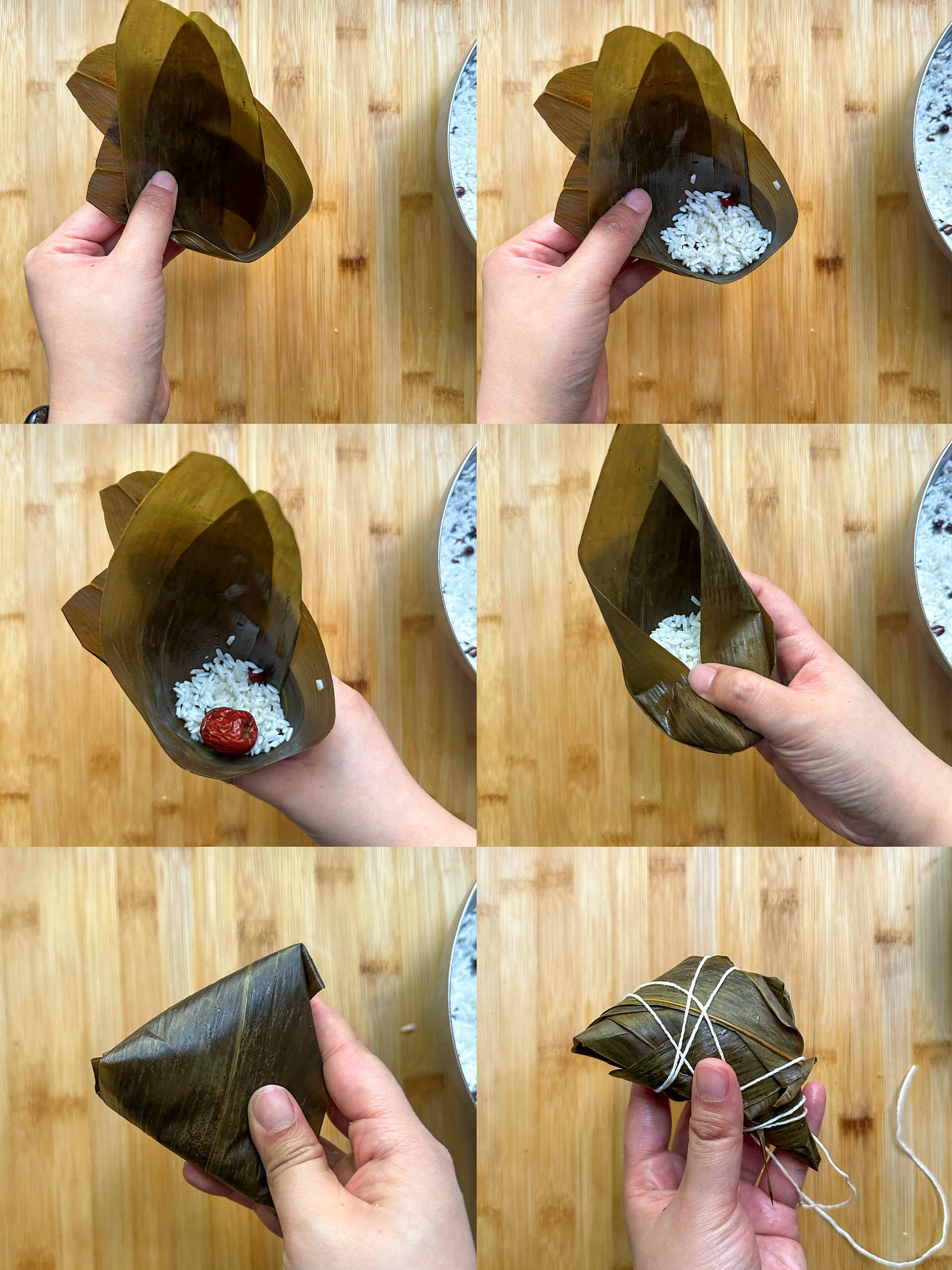
Traveling through China in May, there’s one sight you can’t miss: zongzi (粽子). Whether I was weaving through a bustling farmer’s market in Hangzhou, sitting in a quiet courtyard in Shaoxing’s Anchang old town, or wandering the backstreets of Jiuxiang in the misty mountains of western Sichuan, I kept running into the same scene: local aunties wrapping sticky rice in fresh green leaves. Big leaves soaking in water, nimble fingers folding and tying parcels swiftly while chatting in the local dialect. Steam hissed from high-pressure pots, and the air filled with the grassy, herby scent of the leaves. All signs point to one thing: the Dragon Boat Festival is near.
Dragon Boat Festival, or Duanwu Jie (端午节), falls on the fifth day of the fifth lunar month (this year on May 31). It’s one of China’s oldest and most beloved traditional festivals. Customs vary across regions, but the most iconic include dragon boat races, hanging mugwort at the door, and, most beloved of all, eating zongzi.
From a young age, we were taught the story behind the dish. The most widely accepted origin honors Qu Yuan, a patriotic poet who drowned himself in the Miluo River after learning his state, Chu, had been conquered by Qin during the Warring States period. While schoolchildren may have been more excited about the sticky rice than the tale, we cheekily called the occasion Zongzi Jie—the Zongzi Festival.
Today, zongzi is not only a staple but also a multi-billion yuan industry. Still, traditional handmade zongzi remains a beautiful sight at family-run stalls and local markets, often made with regional variations. A few well-known varieties include: Beijing’s red date zongzi (北京小枣粽子), Jiaxing’s savory pork zongzi (嘉兴肉粽, similar to the kind I had in Shaoxing), and Ningbo’s alkaline zongzi (宁波碱水粽). In Sichuan, there’s one pepper-salt zongzi with beans and cured meat (四川椒盐粽). In my Sichuan family from northeast of the province, we usually ate plain zongzi dipped in white sugar, or sweet versions with red beans and jujube. Later, when I went to college, I fell in love with savory zongzi, particularly those filled with soy-braised pork belly and salted duck egg yolk.

When I told my parents I was working on a zongzi recipe during our recent road trip, it sparked a wave of nostalgia. My mom remembered how, back in her childhood, zongzi were hard to come by—bamboo leaves were scarce, and sometimes the family celebrated with steamed baozi instead, which was also a luxury. When they did manage to make zongzi, they were plain, with no filling.
Fresh zongzi are still a treat here in Berlin. In recent years, I’d only had them as gifts from friends or when ordering them at a restaurant. But after joining a zongzi-making party last year, I gained a bit of confidence and decided it was time to work on a recipe.
I couldn’t manage to sample every zongzi I came across—they’re incredibly filling—but the one I had in Shaoxing stood out. Shaoxing’s pillow zongzi (绍兴枕头粽) was made with pork belly and meigancai (dried preserved mustard greens) and is close to the Jiaxing and Huzhou varieties. Which is close to the recipe I developed based on the video recipe by the Red Note creator, 村驴. Instead of meigancai, mine uses salted duck egg yolk instead. Of course, I wouldn’t dare claim mine could rival the ones made by those skilled aunties but they’re easy enough for me to bring the flavors back to my Berlin home.
And for those who prefer a sweet and plant-based option, there’s one for you too—made with red beans and jujube dates.
Savory Zongzi with Pork Belly and Salted Egg Yolk(蛋黄肉粽)
Makes about 8 zongzi
Ingredients
-
24 dried bamboo leaves
-
5 frozen salted duck egg yolks, defrosted
For the rice:
-
300g glutinous rice
-
2 tbsp light soy sauce
-
1 tbsp dark soy sauce
-
1 tsp sugar
-
½ tsp salt
For the pork filling:
-
250g pork belly, without skin
-
1 tbsp light soy sauce
-
2 tsp dark soy sauce
-
½ tbsp oyster sauce
-
1 tsp grated ginger
-
1 scallion, roughly chopped
-
¼ tsp five-spice powder
-
⅛ tsp white pepper
-
½ tsp sugar
-
¼ tsp salt
Tools:
Kitchen twine, scissors, and a large pot
Instructions:
-
The day before, soak dried bamboo leaves in a large pot or sink, weighted down so they stay submerged. Soak for at least 6 hours or overnight. Wash thoroughly, scrubbing off debris. Keep submerged in clean water until use.
-
Soak glutinous rice for at least 2 hours or overnight. Drain, then mix with light and dark soy sauce, sugar, and salt. Let marinate for 1 hour.
-
Slice the pork belly into big pieces and combine with the marinade. Let it marinate in the fridge for at least 1 hour.
-
Defrost and add the salted egg yolk. Bake in a preheated oven at 180 °C / 350ºF for 10 minutes. Let cool and cut in half.
-
Take two bamboo leaves (smooth side up), overlap them, and shape them into a cone. Add a spoonful of rice, 2–3 pieces of pork belly, a half salted egg yolk, and more rice on top. Fold and wrap tightly into a triangle or pyramid shape. Secure with kitchen twine. (See video/photo for visual guidance.)
-
Place zongzi tightly in a big pot of cold water, making sure they’re fully submerged (use a heatproof plate if needed). Bring to a boil, then simmer on medium-low heat for 2–3 hours covered, until the rice and pork are soft. Let them sit in the hot water until it cools slightly. Alternatively, use a rice cooker (congee setting) for 2 hours.
Sweet Zongzi with Red Beans and Jujube(红枣赤豆粽)
Makes about 8 zongzi
Ingredients
-
24 bamboo leaves
-
300g glutinous rice
-
40g dried red beans (adzuki beans)
-
1 tbsp vegetable oil
-
8–10 dried jujube dates, pitted
-
white sugar or honey for dipping
Instructions:
-
Repeat leaf soaking as above.
-
Soak glutinous rice and red beans for at least 2 hours. Drain thoroughly, add 1 tbsp of vegetable oil, and mix well.
-
Wrap as with the savory version: add a spoonful of rice, a pitted jujube, more rice on top, fold, and tie.
-
Cook the zongzi as above. If you’re making both, cook sweet and savory zongzi in two different pots. Dip in sugar or honey.
Tips for Making Zongzi at Home
Sourcing and preparing ingredients:
You can find most ingredients at large Asian grocery stores. Dried bamboo leaves may be harder to spot—they’re often tucked away in the dried goods aisle, and I’d also ask the staff to help (I used the packaged ones similar to these). I tested banana leaves as a substitute: while usable, they’re stiffer and better for wrapping rectangular shapes.
The ingredients for the filling are not very strict, you can also add dried shitake mushrooms, dried shrimp, and other types of beans to the sticky rice. In the end, I also mixed in some red beans into my savory zongzi.
Planning ahead
Zongzi-making takes time, mostly for soaking and marinating. Set aside at least two days. It’s a great weekend project or group activity. Last year in Berlin, a friend prepped everything in the morning, and four or five of us wrapped and ate them together that afternoon.
My timeline:
-
The night before: Soak bamboo leaves
-
The morning (4 hours before wrapping): Soak rice (and red beans, if using), drain, and marinate the rice
-
The morning (2 hours before wrapping): Marinate pork and refrigerate, and bake the salted egg yolk
-
The wrapping and cooking happen in the afternoon
Wrapping Zongzi:
Zongzi can be wrapped in several shapes—triangle, pyramid, pillow, or long cylinder. For beginners, the triangle is the simplest and most forgiving. I usually use 2 to 3 bamboo leaves per zongzi and prepare the twines beforehand: start with 2, and keep a third on hand in case one tears or doesn’t seal properly. For my recent batch, I experimented with both triangle and pyramid shapes, and not all of them look equally elegant but as long as they’re sealed, you’re fine!
Cooking Zongzi:
Zongzi needs a few hours to cook thoroughly. The most efficient method is a high-pressure cooker (like an Instant Pot), which is also what I saw used by a zongzi vendor in Shaoxing. If you don’t have one, I tested two other methods: 1. A rice cooker on the congee setting: 2 hours. 2. A large pot on the stovetop: 2–3 hours (some recipes call for 7–10 hours, but I’ve found 2–3 is enough for medium to small-sized zongzi)
The longer you cook them, the more tender they become—eventually, the rice and filling nearly melt in your mouth.
Make sure the zongzi stay fully submerged during cooking. You can weigh them down with a heatproof plate or bowl. If the water level gets low, top it off with boiling water to maintain a steady cooking temperature.





